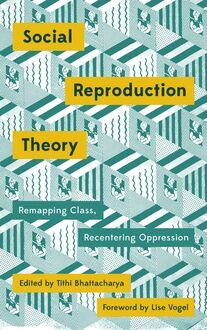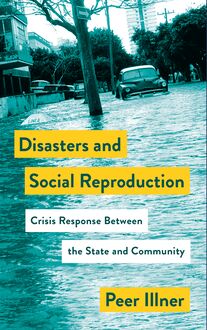Disasters and Social Reproduction , livre ebook
105
pages
English
Ebooks
2020
Vous pourrez modifier la taille du texte de cet ouvrage
Obtenez un accès à la bibliothèque pour le consulter en ligne En savoir plus
Découvre YouScribe en t'inscrivant gratuitement
Découvre YouScribe en t'inscrivant gratuitement
105
pages
English
Ebooks
2020
Vous pourrez modifier la taille du texte de cet ouvrage
Obtenez un accès à la bibliothèque pour le consulter en ligne En savoir plus
Publié par
Date de parution
20 novembre 2020
Nombre de lectures
2
EAN13
9781786805515
Langue
English
Many communities in the United States have been abandoned by the state. What happens when natural disasters add to their misery? This book looks at the broken relationship between the federal government and civil society in times of crises.
Mutual aid has gained renewed importance in providing relief when hurricanes, floods and pandemics hit, as cuts to state spending put significant strain on communities struggling to survive. Harking back to the self-organised welfare programmes of the Black Panther Party, radical social movements from Occupy to Black Lives Matter are building autonomous aid networks within and against the state. However, as the federal responsibility for relief is lifted, mutual aid faces a profound dilemma: do ordinary people become complicit in their own exploitation?
Reframing disaster relief through the lens of social reproduction, Peer Illner tracks the shifts in American emergency aid, from the economic crises of the 1970s to the Covid-19 pandemic, raising difficult questions about mutual aid's double-edged role in cuts to social spending. As sea levels rise, climate change worsens and new pandemics sweep the globe, Illner's analysis of the interrelations between the state, the market and grassroots initiatives will prove indispensable.
Acknowledgements
1. 2005: The Unclaimed Corpses
2. Vulnerability Beyond Resilience
3. Disasters and Social Reproduction
4. 1930: Disasters, Natural and Federal
5. 1970: The Black Panthers' Quest for Dual Power
6. 1995: Poverty, Crime and the Heat
7. 2012: The Strange Success of Occupy Sandy
8. The Separated Society
9. 2020: I Can't Breathe
Notes
Bibliography
Index
Publié par
Date de parution
20 novembre 2020
Nombre de lectures
2
EAN13
9781786805515
Langue
English
Disasters and Social Reproduction
Mapping Social Reproduction Theory
Series editors Tithi Bhattacharya, Professor of South Asian History and the Director of Global Studies at Purdue University; and Susan Ferguson, Associate Professor, Faculty of Liberal Arts, Wilfrid Laurier University
Capitalism is a system of exploitation and oppression. This series uses the insights of Social Reproduction Theory to deepen our understanding of the intimacy of that relationship, and the contradictions within it, past and present. The books include empirical investigations of the ways in which social oppressions of race, sexuality, ability, gender and more inhabit, shape and are shaped by the processes of creating labour power for capital. The books engage a critical exploration of Social Reproduction, enjoining debates about the theoretical and political tools required to challenge capitalism today.
Also available
Social Reproduction Theory:
Remapping Class, Recentering Oppression
Edited by Tithi Bhattacharya
A Feminist Reading of Debt
Luci Cavallero and Ver nica Gago
Women and Work:
Feminism, Labour, and Social Reproduction
Susan Ferguson
Social Reproduction Theory and the Socialist Horizon:
Work, Power and Political Strategy
Aaron Jaffe
Disasters and Social Reproduction
Crisis Response Between the State and Community
Peer Illner
First published 2021 by Pluto Press
345 Archway Road, London N6 5AA
www.plutobooks.com
Copyright Peer Illner 2021
The right of Peer Illner to be identified as the author of this work has been asserted in accordance with the Copyright, Designs and Patents Act 1988.
British Library Cataloguing in Publication Data
A catalogue record for this book is available from the British Library
ISBN 978 0 7453 3955 9 Hardback
ISBN 978 0 7453 3954 2 Paperback
ISBN 978 1 7868 0550 8 PDF eBook
ISBN 978 1 7868 0552 2 Kindle eBook
ISBN 978 1 7868 0551 5 EPUB eBook
This book is printed on paper suitable for recycling and made from fully managed and sustained forest sources. Logging, pulping and manufacturing processes are expected to conform to the environmental standards of the country of origin.
Typeset by Stanford DTP Services, Northampton, England
Simultaneously printed in the United Kingdom and United States of America
For Lianna
Contents
Acknowledgements
1. 2005: The Unclaimed Corpses
2. Vulnerability Beyond Resilience
3. Disasters and Social Reproduction
4. 1930: Disasters, Natural and Federal
5. 1970: The Black Panthers Quest for Dual Power
6. 1995: Poverty, Crime and the Heat
7. 2012: The Strange Success of Occupy Sandy
8. The Separated Society
9. 2020: I Can t Breathe
Notes
Bibliography
Index
Acknowledgements
This book would have not seen the light of day without the many labours - paid and unpaid - of a number of people and institutions. It is to them I wish to express my gratitude. I would like to thank the Department of Arts and Cultural Studies at the University of Copenhagen for having hosted me during the early stages of my research. Thank you to Mikkel Bolt Rasmussen and Isak Winkel Holm, under whose generous supervision the seeds for this project were sown. Also at Copenhagen, I am grateful to the members of the Changing Disasters research group for the stimulating conversations, comradely disagreements, and for offering me a forum to develop my ideas. Generous institutional backing in the later stages of writing was provided by the Research Centre Normative Orders at Goethe University, Frankfurt. I wish to thank my colleagues there for having supported my research throughout.
I have benefitted tremendously from the comments and feedback of Jasper Bernes, Joshua Clover, Mark Neocleous, Devika Sharma, Maya Gonzales, and the participants of the Historical Materialism Conferences at the American University, Beirut in 2017 and at SOAS, University of London in 2018. Heartfelt thanks must also go to my students at the University of Copenhagen, Goethe University, Frankfurt and the Architectural Association, London. Their curiosity, fresh eyes and continued interest enabled me to stay curious myself. I am grateful to the external readers of the manuscript, whose questions, criticisms and queries greatly improved it; in particular Susan Ferguson, Tithi Bhattacharya and an anonymous reviewer. At Pluto Press, I would like to thank David Shulman for his sure-handed guidance of the project from proposal to publication, for his tireless work and enduring enthusiasm; Robert Webb for seeing the book through production and Carrie Giunta for her insightful edits.
For their friendship during the time of writing, my thanks to Bruno Seffen, Octave Perrault, Evan Saarinen, Lucas Liccini, Felix Lennert, Sebastian Glowacki and Alison Hugill. Finally, thank you is not enough to express how grateful I am to Lianna Mark for her love and support and for being there - in disaster and crisis, but above all, beyond.
Parts of Chapter 5 first appeared as Who s Calling the Emergency? The Black Panthers, Securitisation and the Question of Identity in Culture Unbound 7(3), 479-95. An earlier version of Chapter 7 was published as The Locals do it Better? The Strange Victory of Occupy Sandy in Eco-Culture: Disaster, Narrative, Discourse , R. Bell and R. Ficociello, Lanham, Lexington Books, 49-72.
1
2005: The Unclaimed Corpses
Racism . . . is the state-sanctioned or extralegal production and exploitation of group-differentiated vulnerability to premature death.
- Ruth Wilson Gilmore
THE CORPSE IN THE STREET
On 11 September 2005, two weeks after Hurricane Katrina inundated New Orleans, killing at least 1,836 people 1 and destroying much of the city infrastructure, the news network Democracy Now uncovered a scandal that aggravated New Orleanians well beyond the immediate impact of the hurricane: the scandal of dead bodies, rotting in the street. The live broadcast showed an unclaimed corpse, and, standing next to it, Malik Rahim, resident of the neighbourhood of Algiers and founder of the Common Ground network, engaged in the reconstruction of New Orleans. For days, Rahim had been asking city authorities, from the police to the army to the National Guard, to remove an unidentified dead body from the roadside. The kids pass by and they re seeing it, says Rahim:
His body been here for almost two weeks. Two weeks tomorrow . . . that this man s body been lying here. And there s no reason for it. Look where we at? I mean, it s not flooded. There s no reason for them to be-left that body right here like this . . . Every day, we ask them about coming and pick it up. And they refuse to come and pick it up. And you could see, it s literally decomposing right here. Right out in the sun. Every day we sit up and we ask them about it. Because, I mean, this is close as you could get to tropical climate in America. And they won t do anything with it. (cited in Goodman, 2015: min. 49:02)
With Algiers being one of the most heavily policed areas of New Orleans, each city authority in turn drives by the dead body, as if on command. When confronted by the show s anchor Amy Goodman and her camera, they admit to knowing about the body but deny any responsibility in removing it from the site. The Algiers corpse was no isolated case. It later emerged that the retrieval of dead bodies started in earnest only on 9 September, a good ten days after Katrina struck New Orleans. With elderly people of colour in the African American neighbourhoods of the Lower Ninth Ward and Lakeview constituting the vast majority of disaster victims, black residents were left to reckon with the wreckage, with the smell of their decomposing neighbours infesting the tropical air.
Those same rotting bodies ignored by city authorities make manifest the systematic omission in scholarly attempts to make sense of events. While critical accounts have focused on how pre-existing social injustices made African American New Orleanians disproportionately vulnerable to hurricane damage (Laska and Morrow, 2006; Tierney, 2006; Brunsma, 2010), on how the federal rescue operations were influenced by racial prejudice (Tierney, Bevc et al., 2006; Russill and Lavin, 2011) or on how the Bush administration used the disaster to advance neoliberal pro-business reforms (Klein, 2007; Adams, 2012; Adams, 2013), a thorough analysis of disaster relief as a question of who clears out the dead remained conspicuously absent. Filling the analytic gap that was left behind when the waters retreated, this book is dedicated to answering that question. It argues that disasters are primarily a problem for social reproduction, understood, following political theorist Nancy Fraser, as the capacities available for birthing and raising children, caring for friends and family members, maintaining households and broader communities (2017:21).
In this view, disaster relief becomes a form of reproductive labour, akin to childcare, elder care or gravedigging, and indeed often involving all three. When seen through the lens of social reproduction, disasters pose the question of who should perform these elemental tasks. This question touches on the fundamental distinction between the state and civil society, 2 thus challenging political life as we know it. This book argues that, far from being an exception, the handling of disaster victims by neighbours and relatives during Hurricane Katrina exemplifies a wider trend. In America today, disaster relief is increasingly shouldered by civil society, in an attempt to make up for the state s reluctance to deliver this essential service.
A thorough theorisation of relief work as a form of reproductive labour is as yet still missing. Little has been written on the structural transformations of the disaster aid sector, including the changing roles of the state and civil society in the face of disaster. Instead, from the 1755 Lisbon earthquake to Hurricane Katrina, from 9/11 to the 2010 Haitian earthquake, the ele


